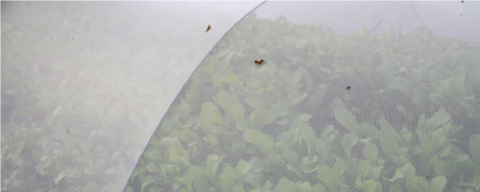IPM tools for Delia spp. Attacking Vegetable Crops
Recent changes in local and federal pesticide laws in our region have led to a push by researchers to develop better IPM strategies for managing Delia Species. Three Delia species that commonly limit crop production are seedcorn maggots, onion maggots and cabbage maggots.
These three species have slightly different life histories and host plant preferences, but management strategies are typically the same. If we can prevent flies from laying eggs with physical barriers or chemical insecticides, we can avoid crop damage from larvae. You can find more information in the New England Vegetable Management Guide about using IPM strategies for monitoring and managing seedcorn maggot in bean and peas (https://nevegetable.org/crops/insect-control-1 ), onion maggot in onion and other allium crops (https://nevegetable.org/crops/insect-control-14 ), and cabbage maggot in cabbage and other brassica crops ( https://nevegetable.org/crops/insect-control-3 ).
Deploy yellow sticky traps in fields where you are preparing to plant to determine if flies are present. Place 3-inch by 5-inch yellow sticky traps on wooden or wire stakes above the soil level. Check and change twice weekly to determine changes in adult activity. Monitoring typically begins in early to mid-May. Growing degree day models can be used to more accurately predict peak flight periods when crops are at highest risk. You can find degree days models for all three pest species, using weather data collected from YOUR neighborhood, at https://newa.cornell.edu/.
GDD for peak flights of key maggot fly pests
(Base T = 40°F)
|
Peak Flight |
Seed Corn |
Onion |
Cabbage |
|
1st gen |
360 |
735 |
452 |
|
2nd gen |
1080 |
1752 |
1261 |
|
3rd gen |
1800 |
2975 |
2176 |
|
4th gen |
- |
- |
3014 |
-Source: UMass Extension Vegetable Program (https://ag.umass.edu/vegetable/fact-sheets/onion-maggot)
Row cover or netting is typically deployed at planting, and many will deploy some kind of physical barrier as soon as the field is prepared because flies are attracted to odors from soil microbial activity that can be enhanced by tillage. If row covers are implemented, growers ensure that they have rotated out of fields recently planted with Brassicas. Many opt for using chemical control at planting, if they are planting at a time of high risk of infestation. However, many of the standard treatments, like treated seed or drench applications, may no longer be available. Neonicotinoid seed treatments are no longer allowed within some states in the region. Drench treatments of chlorpyrifos (Lorsban) are no longer allowed on food crops nationally. Researchers have been evaluating alternative approaches.
For example, Salgado et al. (2023) found a tray drench application of Verimark provided better control of cabbage maggot infesting green cabbage than four applications of Mustang Maxx (pyrethroid) applied at planting and 7, 14, and 21 days after planting. Scheufele et al. (2015), found that tray drenches of Verimark were more effective at preventing cabbage maggot infestations than Lorsban applied as a band at planting. The active ingredient in Verimark, cyantraniliprole, has broad spectrum activity on several pest species (e.g. caterpillars, flea beetles) and is systemic in the plant, but this class of insecticides (diamides) have no mammalian toxicity and have a relatively lower risk to non-target organisms in the environment. Foliar applications of pyrethroids (like Mustang Maxx, Warrior) can be very disruptive to the natural enemies that contribute biological control in strong IPM programs. Even though these products are less expensive per application, they often need to be applied more frequently and this can flare secondary pests like aphids.
You should always read your labels before making pesticide applications, but make double sure to read those labels if you are considering tray drench applications because this application may not be allowed when using certain products.
For more information on the species discussed above, please click on the fact sheets linked below:
Any reference to commercial products, trade or brand names is for information only, and no endorsement or approval is intended. The user of this information assumes all risks for personal injury or property damage.
Warning! Pesticides are dangerous. Read and follow all instructions and safety precautions on labels. The label is the Law!
Extension Services & Tools That Help NH Farmers Grow
Newsletters: Choose from our many newsletters for production agriculture
Receive Pest Text Alerts - Text UNHIPM to (866) 645-7010

